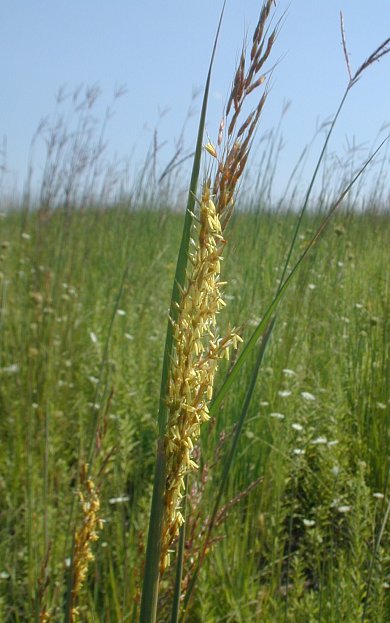Difference between revisions of "Sorghastrum nutans"
(→Distribution) |
|||
| Line 30: | Line 30: | ||
==Ecology== | ==Ecology== | ||
===Habitat=== <!--Natural communities, human disturbed habitats, topography, hydrology, soils, light, fire regime requirements for removal of competition, etc.--> | ===Habitat=== <!--Natural communities, human disturbed habitats, topography, hydrology, soils, light, fire regime requirements for removal of competition, etc.--> | ||
| − | ''S. nutans" is found in xeric and mesic woodlands and forests and along powerline right-of-ways and roadbanks.<ref name="Weakley 2015"/> | + | ''S. nutans" is found in xeric and mesic woodlands and forests and along powerline right-of-ways and roadbanks. |
| + | It is one of the dominant grasses of tall-grass prairies.<ref name="Weakley 2015"/> | ||
===Phenology=== <!--Timing off flowering, fruiting, seed dispersal, and environmental triggers. Cite PanFlora website if appropriate: http://www.gilnelson.com/PanFlora/ --> | ===Phenology=== <!--Timing off flowering, fruiting, seed dispersal, and environmental triggers. Cite PanFlora website if appropriate: http://www.gilnelson.com/PanFlora/ --> | ||
Revision as of 13:57, 17 January 2018
| Sorghastrum nutans | |
|---|---|

| |
| Photo by John Hilty hosted at IllinoisWildflowers.info | |
| Scientific classification | |
| Kingdom: | Plantae |
| Division: | Magnoliophyta - Flowering plants |
| Class: | Liliopsida - Moncots |
| Order: | Poales |
| Family: | Poaceae |
| Genus: | Sorghastrum |
| Species: | S. nutans |
| Binomial name | |
| Sorghastrum nutans (L.) Nash | |

| |
| Natural range of Sorghastrum nutans from USDA NRCS Plants Database. | |
Common Name(s): yellow indiangrass;[1] indiangrass[2]
Contents
Taxonomic Notes
Synonym(s): S. avenaceum[1]
Description
Distribution
This species can be found in 42 of the 48 lower United States, from Arizona, northward through Utah, Wyoming, and Montana, and all states eastward. It also occurs in parts of Quebec, Ontario, Manitoba, and Saskatchewan provinces of Canada.[2]
Ecology
Habitat
S. nutans" is found in xeric and mesic woodlands and forests and along powerline right-of-ways and roadbanks.
It is one of the dominant grasses of tall-grass prairies.[1]
Phenology
Flowering occurs from late August through October.[1] A report of flowering in November also exists.[3]
Conservation and Management
Cultivation and restoration
Photo Gallery
References and notes
- ↑ 1.0 1.1 1.2 1.3 Weakley AS (2015) Flora of the Southern and Mid-Atlantic States. Chapel Hill, NC: University of North Carolina Herbarium.
- ↑ 2.0 2.1 USDA NRCS (2016) The PLANTS Database (http://plants.usda.gov, 17 January 2018). National Plant Data Team, Greensboro, NC 27401-4901 USA.
- ↑ Nelson G (17 January 2018) PanFlora. Retrieved from gilnelson.com/PanFlora/